Dartmouth College in Hanover, New Hampshire, has corralled much of its experimental architecture along the edges of its campus, which is otherwise dominated by Georgian and colonial quadrangles in brick and white clapboard. At the south-east corner, a few imaginative buildings dedicated to the arts are huddled together. The best so far is the Hood Museum of Art, which was originally designed in the 1980s by the influential postmodernist Charles Moore. Its gabled brick pavilions are crowned in a playful domed finial with a necklace of raised copper triangles. Moore laid out a meandering entry path from the campus’s main green, meant to pique curiosity. He flanked a gateway with layers of square columns, which allowed glimpses of courtyard space and galleries beyond. But there was hardly any signage to point the way, and the gateway’s brick, concrete and copper surfaces aged poorly during New England winters. It ended up streaked in grey and green, looking as forbidding as a mausoleum door.
The Hood’s current director, John Stomberg, tells me during my recent tour that for many students, their families, alumni, neighbours and passers-by, Moore’s scheme was ‘so obtuse you didn’t know where to enter’. At times, he adds, students even thought that they were not allowed inside. Stomberg has overseen a $50 million renovation and expansion by the Manhattan firm Tod Williams Billie Tsien Architects (TWBTA) that adds clarity as well as badly needed classrooms, offices, an atrium and six more galleries (Moore had provided ten). The ever-growing permanent collection (the current object count is around 65,000) spans from Assyrian palace reliefs to 19th-century Native American battlefield sketches on recycled ledger pages, Papua New Guinea headdresses made of cassowary and heron feathers and a painting from 2018 by Ethiopian-American artist Julie Mehretu, with ghostly outlines of buildings lost in Aleppo’s wartime chaos.
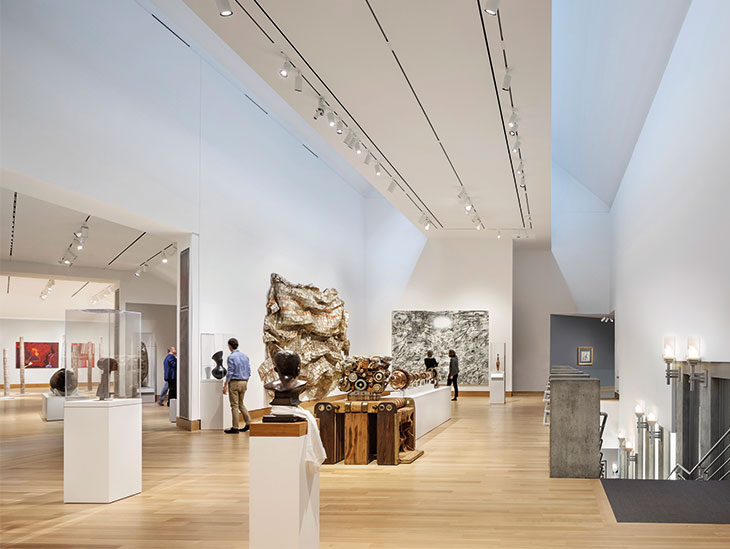
The renovated second-floor galleries feature installations of contemporary Aboriginal Australian art, Melanesian art and contemporary African art – including, on the far wall, Iridium over Aleppo (2018) by Julie Mehretu, and to its left Hovor (2003) by El Anatsui. Photo: © Michael Moran
The Hood’s visitor pool is as varied as its acquisitions. Each year, thousands of schoolchildren from around the region take field trips to the galleries. There are no entry fees, and few rival institutions nearby (the closest encyclopaedic collection belongs to the Museum of Fine Arts, Boston, a three-hour drive away). Dartmouth undergraduates in every academic track are required to take some art classes – Mary K. Coffey, an art historian on the faculty, tells me that many of her students had never even visited a museum before. Students who take upper-level courses, such as the ‘Museum Collecting 101’ seminar, are allowed to select artworks for the Hood to buy. ‘It’s an experiment, it’s a laboratory,’ Stomberg says. ‘We’re basically like a kunsthalle, with a collection – it’s an oxymoron, but what the heck.’
When I visit, ‘Museum Collecting 101’ veterans have just hung a show of their recommended acquisitions of contemporary photos, titled ‘Consent: Complicating Agency in Photography’. Their wall texts examine, among other issues, the choices that photographers have made when creating self-portraits. The long-forgotten, rediscovered Chicago photographer Vivian Maier captured herself unsmiling and mirrored in storefronts; Korean-born Nikki S. Lee has posed wearing a blonde wig and leaning morosely out of the doorway of a ramshackle home in an Ohio trailer park.
Stomberg leads me past New Guinea wooden drums, masks and shields in polychrome swirling patterns, and through a forest of cross-hatched poles carved by Aboriginal Australians. A grey-haired teacher monitors a grey-haired class as everyone chooses an elaborately coiffed African mask to sketch; she asks if they can feel any brain shifts as they draw. We circle a teepee-shaped sculpture that Jeffrey Gibson (who has Choctaw-Cherokee ancestry) made in 2016; he topped it with a birdlike ceramic head that is poking out its tongue, and draped its body in bells and fringe. Near Mehretu’s lament for Aleppo, Stomberg explains the messages about consumption, colonial after-effects and resource exploitation that underlie El Anatsui’s undulating weavings made from aluminium bottle tops and Elias Sime’s arid landscapes pieced together from cast-off motherboards.
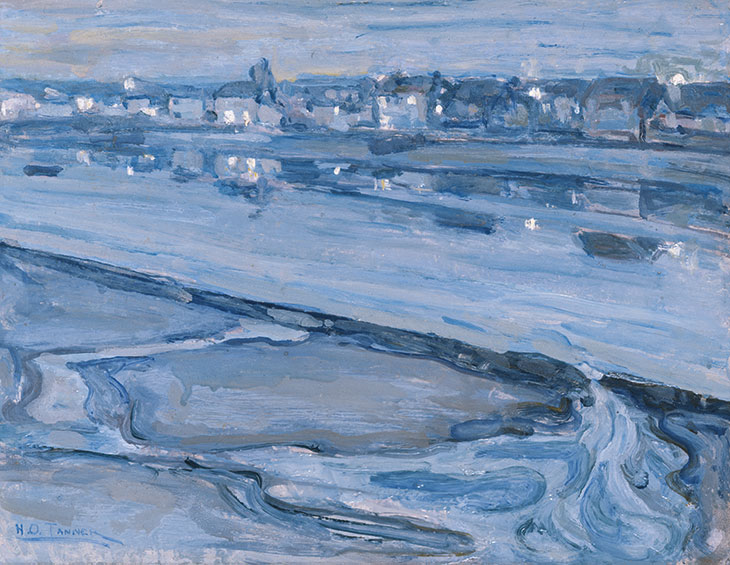
Étaples and the Canche River at Dusk (c. 1918), Henry Ossawa Tanner. Hood Museum of Art, Dartmouth College, New Hampshire. Photo: courtesy Michael Rosenfeld Gallery LLC, New York, NY
Side galleries contain somewhat more predictable works: a Calder mobile, a Rothko abstraction, Picasso’s Guitar on a Table (1912). In Perugino’s 16th-century tableau Virgin and Child with Saints, barefoot men gaze up at Mary and her infant perched on a pedestal; the painting has been studied in various classes including ‘Sex and Gender in the Italian Renaissance’. Underappreciated masters from the 19th and early 20th centuries also get their due. There are calm waterfront scenes by the African-American painters Robert Seldon Duncanson and Henry Ossawa Tanner, and luminous portraits of women by Cecilia Beaux and Lilly Martin Spencer. A grey-green stoneware jar was made in South Carolina around 1830 by the enslaved potter David Drake. Stomberg shows me where some details in the artworks converse with one another. Snakes sprout from the forehead and ribcage of Harriet Hosmer’s marble bust of Medusa from the 1850s, not far from Lawrence Alma-Tadema’s 19th-century painted vision of an ancient Roman sculpture gallery, in which a slave shows prospective buyers a monumental bronze or carved-porphyry tazza encircled by the sea monster Scylla. Stomberg talks about his wishlist to fill collection gaps; more comprehensiveness will require purchases or gifts of works by Matisse, Bonnard, Warhol, Rauschenberg, Jasper Johns, and Roy Lichtenstein. Oh, and a Roman portrait bust, he adds: ‘But we haven’t found one on the market yet with a great pedigree and provenance.’
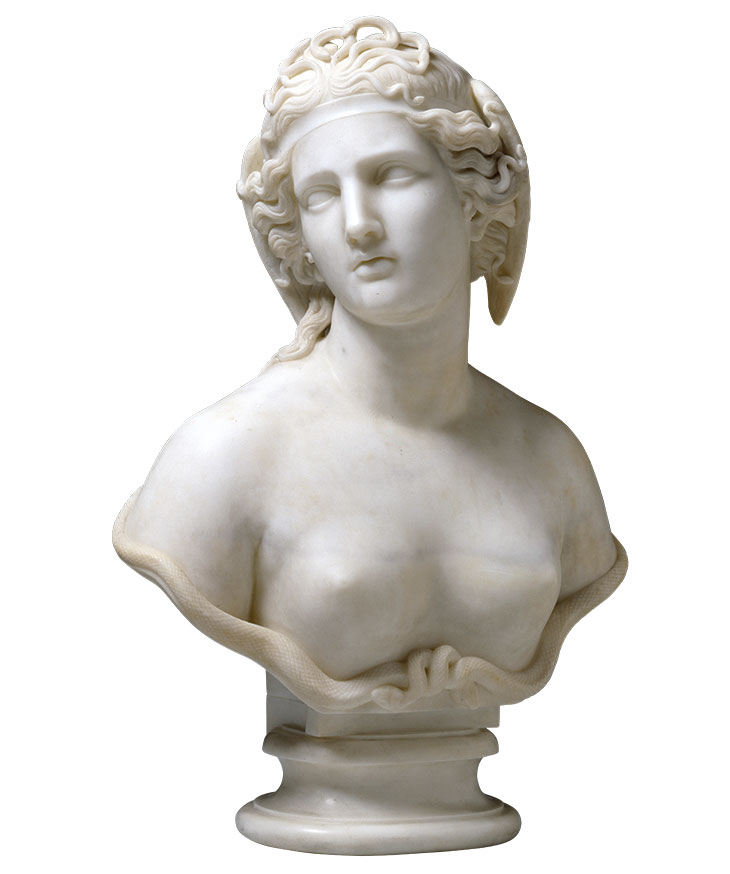
Medusa (c. 1854), Harriet Goodhue Hosmer. Hood Museum of Art, Dartmouth College, New Hampshire
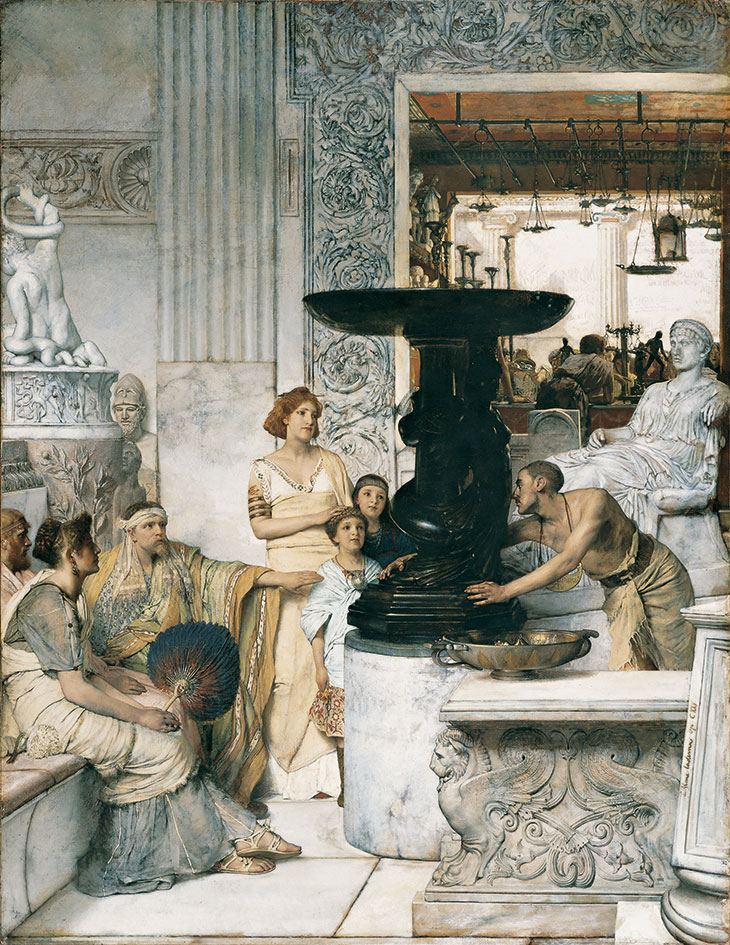
The Sculpture Gallery (1874), Lawrence Alma-Tadema. Hood Museum of Art, Dartmouth College, New Hampshire
Dartmouth started its collection of art and objects soon after the school opened in 1769. Among the first donations were fragments of mastodon tusks excavated in Kentucky and a ruffle-edged silver bowl made in Boston (which is now on view in a case full of American silver). Over the centuries, museum displays were installed at various buildings, including at one of the Hood’s immediate neighbours, Wilson Hall, a turreted Romanesque former library built in the 1880s. The Hood’s construction in the 1980s was financed by alumnus Harvey P. Hood, whose family had made a fortune in dairy products. (How fortunate for Dartmouth, in this age of reckoning, that its museum was not named for any donors now considered scoundrels.)
The Hood site is sloped and narrow, tucked between Wilson Hall and a 1960s theatre building, the Hopkins Center for the Arts, designed by modernist Wallace K. Harrison. The Hop, as it is commonly known, is fronted in concrete archways and cantilevers. (It foreshadowed Harrison’s headquarters for the Metropolitan Opera at Manhattan’s Lincoln Center.) Moore described his contribution to the campus as unobtrusive, in reaction to modernists’ ‘macho constructions that show off their own muscles’, he told the New York Times in 1985, adding: ‘The world is ripe for buildings that slide in between and make things nicer for themselves and everyone else.’
The Hood attracted gifts in large batches, including New Guinea woodcarvings from Los Angeles collector-dealer Harry A. Franklin and Native American ledger drawings from the art historian Mark Lansburgh. But there was limited room to show them. Classroom space was cramped as faculty incorporated art into the curricula; Coffey says she sometimes feared objects would get damaged in the crowds. There was little flexible indoor space for events, and the winters pummelled Moore’s gables and the unsheltered courtyard and steep walkway. Temporary wooden sheds were required to protect people from snow avalanches, and the paving was prone to puddles and ice. The access route to great art, Coffey says, ‘wasn’t particularly inviting or pleasant’.
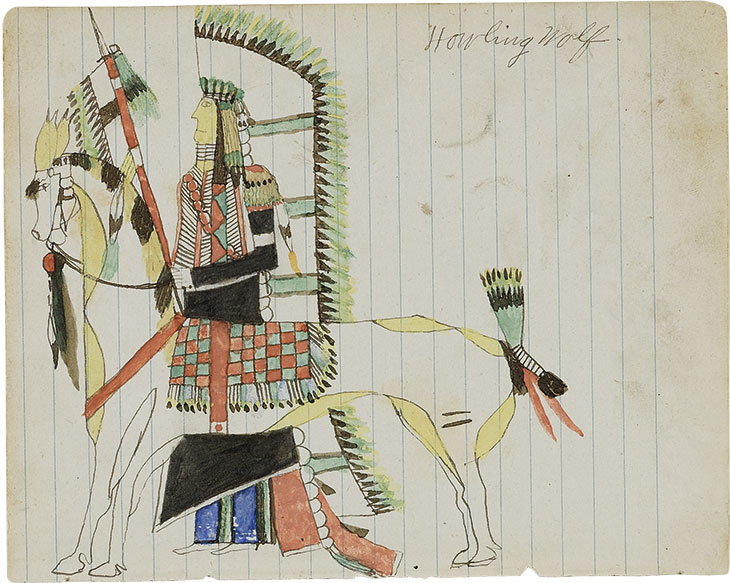
Untitled (Howling Wolf with his War Horse) (c. 1874–75), Howling Wolf (Ho-na-nist-to). Hood Museum of Art, Dartmouth College, New Hampshire
Stomberg arrived in 2016 (he had previously headed the Mount Holyoke College Art Museum), when construction plans and fundraising were well underway. ‘When I got here, we shifted into high gear,’ he says. Ground was broken a few months later. Moore’s defenders meanwhile protested against TWBTA’s partial erasure of the original building and gateway. Eugene J. Johnson, a Williams College historian, told the New York Times that the proposed pale-grey brick addition with an off-centre square bay window amounted to ‘an enormous white cake box’. (Its colour has been waggishly attributed to the Hood dairy fortune.) TWBTA has pointed out that the firm has the greatest respect for Moore’s oeuvre – Tsien had been one of his protégées as an architecture student in the 1970s – and Tod Williams has described the firm’s Hood project as ‘a complementary dialogue between old and new’.
Much of the 1980s brick skin has been preserved, along with the signature domed finial. The galleries and staircases still have Moore’s expanses of raw concrete and quirky ziggurat forms sculpted on the column capitals and light fixtures. A variety of dark and pale oak floorboards adds a sense of patina to the redone galleries. Sunlight streams in through skylights, staircase windows and the bay, which keeps visitors oriented as they roam through displays that explore continents and millennia. For visitors crossing from old to new sections, Stomberg says, ‘It’s a seamless experience.’
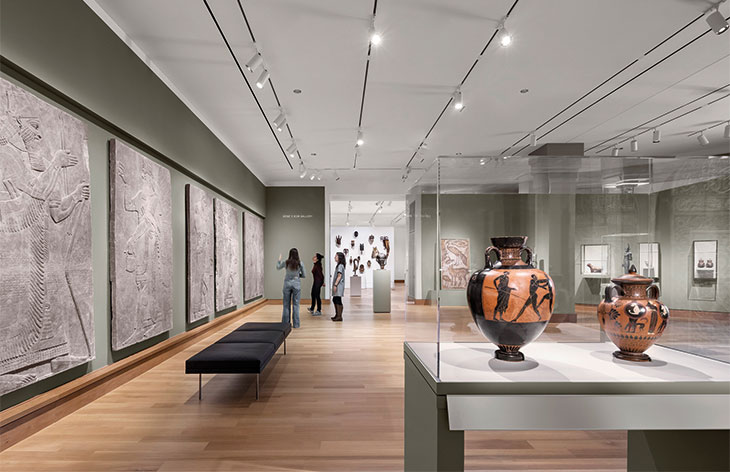
Ancient art in the newly renovated Kim Gallery includes, along the left-hand wall, reliefs from the north-west palace of Ashurnasirpal II at Nimrud, 883–859 BC. A display of traditional African art is visible in the Albright Gallery beyond. Photo: © Michael Moran
A wall full of Assyrian gypsum panels, depicting processions of royalty and genies, was deemed too fragile to move out of the way during construction, and it remains where Moore installed it. A ‘fortress’ was built around them, Stomberg says, for safekeeping while the museum was gutted and expanded. In the 1850s, Dartmouth emissaries had laboriously excavated the stone carvings from palace ruins at Nimrud, near modern-day Mosul, Iraq – militants pulverised that wondrous site in 2016. In the new Hood gallery, the gypsum survivors have been shown alongside a translucent plastic miniature of a winged Assyrian figure that the Iranian-born artist Morehshin Allahyari has made with a 3D printer.
Reactions to the renovations and addition have been largely favourable so far, albeit with some traces of nostalgia. A typical example is Michael J. Lewis’s review in the Wall Street Journal, which lamented the loss of Moore’s ‘rambling discursive quality’ but praised the new galleries as ‘generously proportioned and finely detailed’. I personally find the pale brick facade a little jarring, contrasting too brightly with 1880s Wilson in red and Harrison’s 1960s concrete swoops. The off-centre bay, moreover, seems Cyclopean. But some winters may well soften the effect of the Hood, and perhaps some vines will be allowed to creep across – a few tendrils have already arrived when I visit.
The lofty atrium, lined in the same brick, is already serving as a major campus attraction – students are there at all hours, zoning out, chatting, or pecking anxiously at laptops. ‘I just found out, we’ve become a cool place to have a date,’ Stomberg says. A bronze man sculpted by Juan Muñoz dangles over the room, which is kept open from dawn until midnight. The museum has some evening hours, and I stay in the galleries until closing time, while students are throwing a party in the atrium. Live saxophone music wafts upstairs while I pause in the new protruding bay. Stomberg says he is hoping to schedule some dance performances in the window, which has a sweeping view of the Georgian and Colonial campus. Students stream below me on their way to the Hood or the Hop, illuminated by twinkling streetlights and the glow of their phones. No one looks up at me, framed in the new Cyclopean opening, briefly suspended in art and architecture and time.
From the May 2019 issue of Apollo. Preview the current issue and subscribe here.
Unlimited access from just $16 every 3 months
Subscribe to get unlimited and exclusive access to the top art stories, interviews and exhibition reviews.

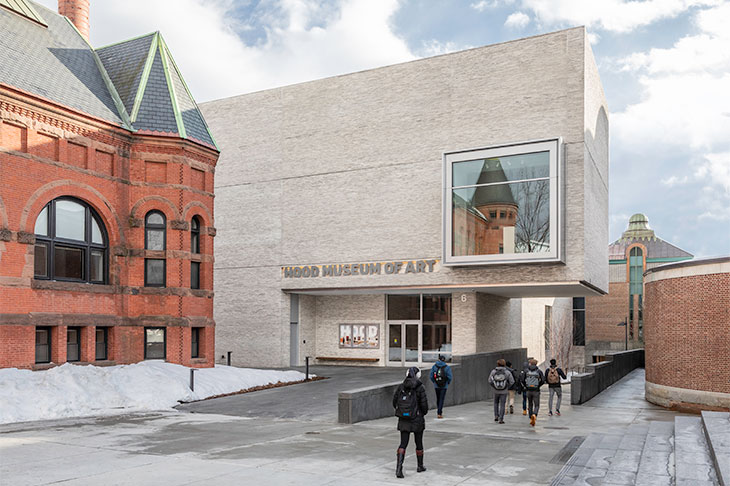
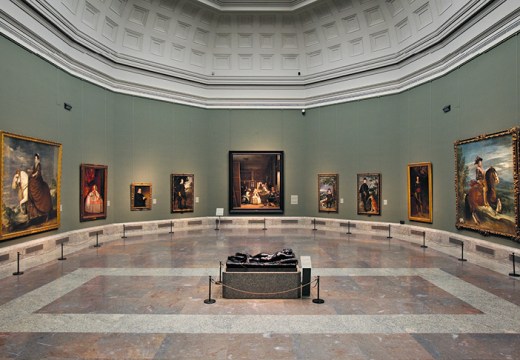
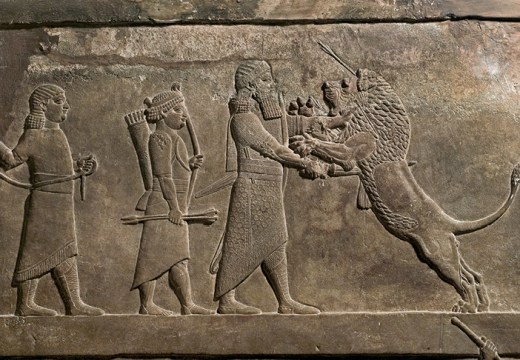










![Masterpiece [Re]discovery 2022. Photo: Ben Fisher Photography, courtesy of Masterpiece London](http://www.apollo-magazine.com/wp-content/uploads/2022/07/MPL2022_4263.jpg)
It’s time for the government of London to return to its rightful home